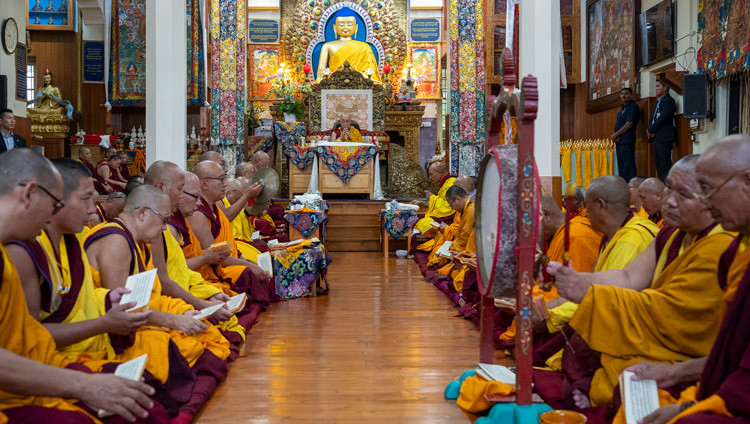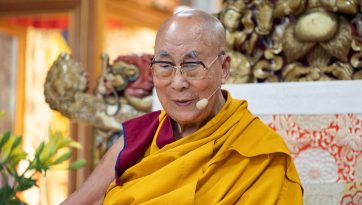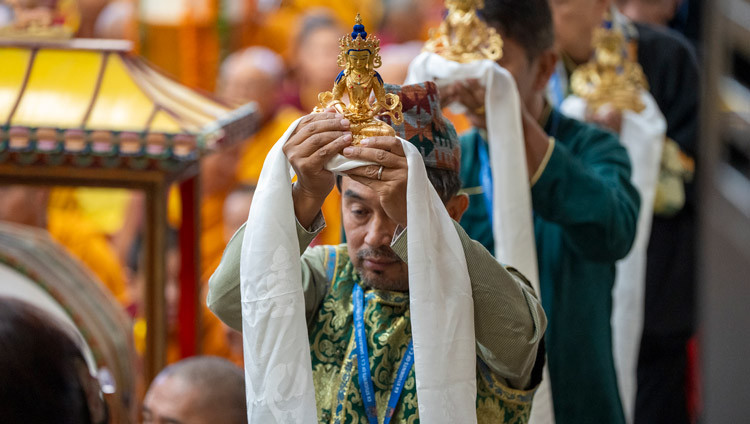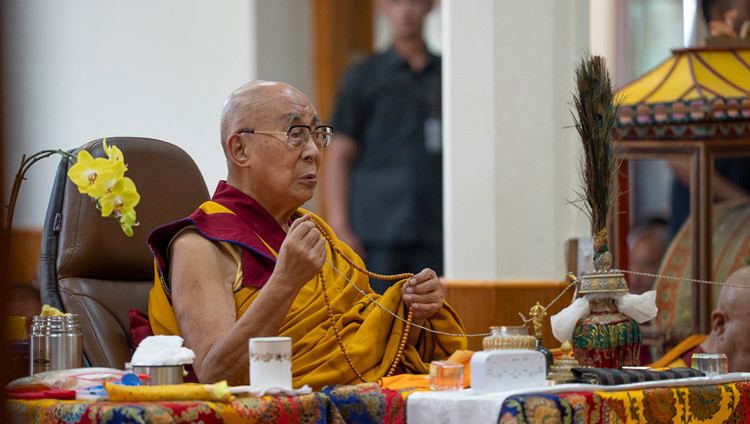Tibetan Culture and Its Potential to Contribute to Peace
August 25, 2021
Thekchen Chöling, Dharamsala, HP, India – This morning Tenzyn Zöchbauer, Executive Director of the Tibet Initiative Deutschland, welcomed His Holiness the Dalai Lama to a conversation on the theme ‘Tibetan Culture and its Potential to Contribute to Peace’. She told him that 50 Tibet supporters and Tibetans in Germany, Switzerland and Austria were participating in the online interaction, while many more were watching across the world.
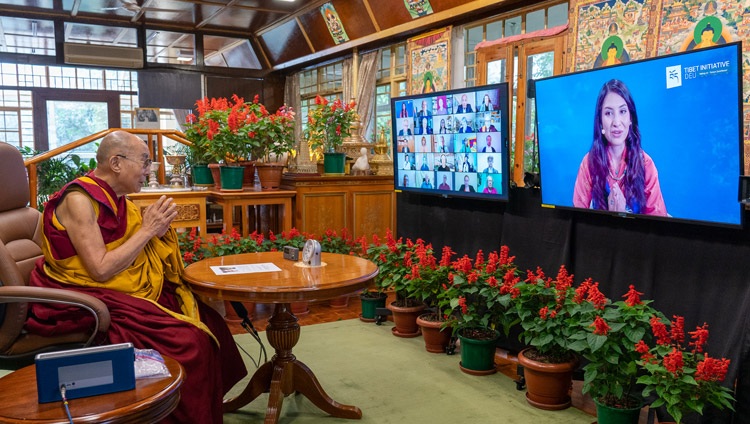
“I’m very happy to have this opportunity to take part in discussions with German friends,” His Holiness replied. “Since my childhood I’ve had a soft spot for Germany. I was aware that Germany was defeated in both the first and second world wars.
“In Tibet we had two visitors, Aufschnaiter and Harrer who, because they spoke German, we thought of as Germans. I didn’t have much personal contact with Aufschnaiter, but I became friends with Harrer. He was the first person to teach me English, but it was only later that I realized that his English was actually quite poor and that’s where my broken English began.
“As I mentioned before, Germany was defeated in the second world war, as was Japan, after being subject to nuclear attack. Consequently, strong peace movements came about in both countries. Both the German and Japanese peoples showed a real desire for genuine peace and both have contributed to creating a more peaceful world.
“With regard to Tibetan culture, we were originally a nomadic people with a fairly simple way of life. Then in the seventh century, the King of Tibet, Songtsen Gampo, married a Chinese princess. He decided Tibetans should have their own means of writing, but instead of following the Chinese model, he chose to base it on the Indian alphabet and its Devanagari script.
“In the eighth century, King Trisong Detsen wanted to introduce Buddhism to Tibet and again he chose to turn not to China but to India for help. At that time, Nalanda University was the most renowned centre of learning. Trisong Detsen invited one of the foremost scholars, Shantarakshita to the Land of Snow. When he realized that Tibetans had their own written language, Shantarakshita strongly encouraged the translation of Indian Buddhist literature into Tibetan. As a result, Tibetan and Indian scholars worked together and translated the collection of the Buddha’s words into 100 volumes and the collection of treatises by subsequent Indian masters into more than 200 volumes. This was the start of the Tibetan cultural heritage.
“We regard Indians as our teachers. Sometimes I jokingly observe that those of us who were originally the disciples eventually became the gurus. Because we paid such close attention to the Buddhist literature we had acquired, I believe ours is now the most comprehensive Buddhist tradition. Following the pattern of the Nalanda Tradition and inspired by the Buddha’s admonition to test and examine his teachings before accepting them, we have thoroughly investigated Buddhist teachings. We have studied, but, mindful of the Chinese example, we have also meditated.
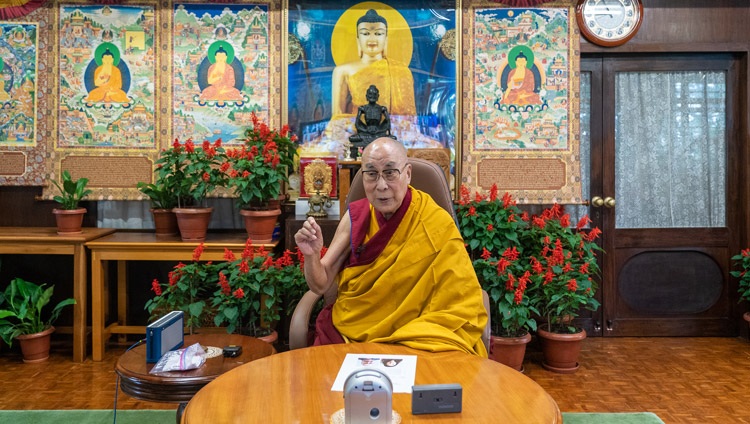
“We memorize the principal texts, something I too did as a young boy. But the unique factor is that we then take a strictly logical approach to scrutinizing the meaning of what is written. This is not the custom in either the Pali or Chinese traditions. We follow the example set by Chapa Chökyi Sengé who formalized the Tibetan system of debate.
“These days, as I said before, conversations with many Buddhist scholars have led me to believe that what Tibetans have maintained and preserved is the most comprehensive Buddhist tradition. We study, but we also cultivate ‘shamatha’, concentration, and ‘vipashyana’, insight meditation. We not only cultivate warm-heartedness and compassion; we use our intelligence and look at things logically.
“Our ability to explain how to cultivate compassion and achieve peace of mind means we can contribute to peace in the world. Even those with no interest in religion want to find peace within. They too can benefit from learning that we face all kinds of trouble because our minds are disturbed.
“We start life in the shelter of our mother’s affection. Without it we would not survive. It’s the experience of our mother’s compassion that sows in us a seed to be kind to others when we grow up. However, modern education pays little attention to the way such positive emotions contribute to peace of mind and general good health. Nor does it reveal how anger disturbs our minds and disrupts the communities in which we live. It is in all our interests to learn how to achieve peace of mind and Tibetan culture has kept alive a variety of means for bringing it about.”
His Holiness answered a series of questions from the audience, some of which were addressed to him in Tibetan, some in German and others in English. Several dealt with how Tibetan culture can be preserved in Tibet.
His Holiness observed that when the Chinese first occupied Tibet their leaders were driven by a strong ideology. He recalled his last meeting with Chairman Mao in which the revolutionary leader praised him for the scientific cast of his mind, but teased him with his insistence that religion is the opium of the people. Since then, attitudes have changed and growing numbers of Chinese are showing a renewed interest in Buddhism.
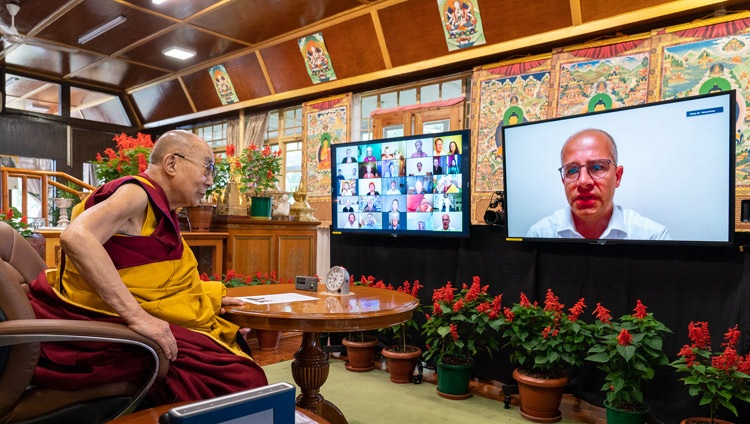
He reported that friends involved with education in China have told him that university professors have gained access to Chinese translations of the two volumes of ‘Science and Philosophy in the Indian Buddhist Classics’ that have been compiled by Tibetans in India from sources in the Kangyur and Tengyur. The professors were surprised to acknowledge that Tibetan Buddhism belongs to the Nalanda Tradition, clearly adopting a scientific approach rooted in reason and logic.
His Holiness remarked that Chinese communists exerted maximum pressure against Tibetan Buddhism but failed to destroy it. Now, Tibetan Buddhism is attracting interest not only in China but around the world.
His Holiness described how, when he reached India, he proposed setting up schools for Tibetan children that would teach Tibetan. Nehru was fully supportive. In due course, the monastic centres of learning were re-established too. These days several thousand monks and nuns have the opportunity to study rigorously. Young Tibetans who wish to join them must first master Tibetan which will equip them to study, become scholars themselves and so preserve the Tibetan tradition.
His Holiness pointed out that wherever Tibetans have settled efforts have been made to enable them to learn written and spoken Tibetan. Similarly, across the Himalayan region initiatives have been taken not only for monastics, but for lay-people, young and old, to study and practise debate.
With regard to working for peace in the world, His Holiness affirmed that he takes a secular approach. For him the key factor enabling individuals, families and communities to be happy is to find peace of mind. And the foundation for this is compassion.
As for the survival and flourishing of Tibetan Buddhism, His Holiness reiterated that historically China has been a Buddhist country. These days there is a growing revival of interest in what Buddhism has to say in terms of philosophy, reason and psychology. He feels it’s helpful to note correspondences between Buddhist thought and observations made in relation to quantum physics, for example.
His Holiness referred to a question about the growing power of the Chinese Communist Party government as complicated. He observed that no matter how powerful China becomes, it is still part of the world and has to live peaceably with other nations. India and China have to live side by side. The question of Taiwan may be politically complicated, but the fact remains that the Chinese cultural heritage has been purely preserved on the island.
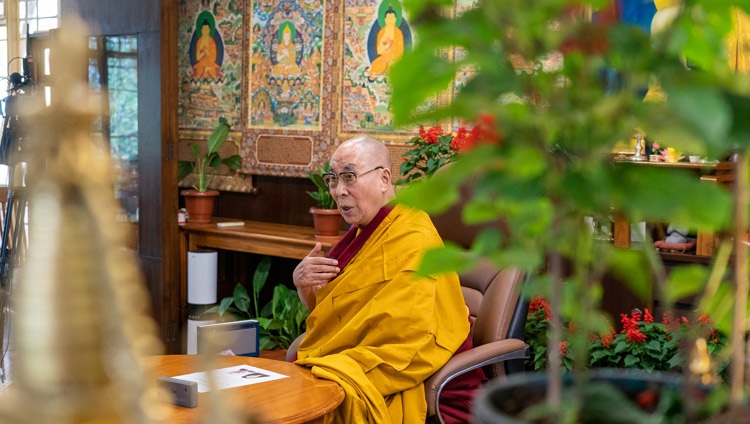
“Politically short-sighted decisions may be made,” he said, “but in the long run China has to live with its neighbours. Things are changing and, in some ways, people are more open and realistic than they were before.”
Asked how people can find truthful information about serious issues like climate change and the covid pandemic His Holiness noted that in the past when most people lived in isolation it was difficult to know what was true. These days mobile phones and the internet provide an endless source of information so it’s necessary to be wary about what’s true. As far as climate change is concerned, if we don’t act, sources of water everywhere will be drastically reduced. It’s even suggested that rivers in Tibet will dry up and the land will come to resemble the deserts of Afghanistan.
This may seem far-fetched, but the rate at which glaciers are melting in the Arctic and Antarctic suggest that the situation in Tibet is equally serious. Global problems need global solutions. Where in the past we may have been inclined to concern ourselves only with our own local difficulties, now we must consider the needs of the whole world.
When people fall victim to floods and wildfires, he said, it’s important that we communicate our care and concern and provide whatever help we can. Just as it’s crucial to let them know they’re not forgotten, it’s essential to remember the oneness of humanity.
Coming back to the question of how to preserve Tibetan culture, His Holiness suggested that taking an interest in it is a practical step. It’s not so much a question of maintaining customs for their own sake, but of preserving the knowledge the cultural tradition conveys. In this case, what is useful and beneficial is the means to cultivate peace of mind and so contribute to peace in the world.
Tenzyn Zöchbauer thanked His Holiness for his advice, the audience for listening and asking questions and the team of interpreters for their simultaneous translations. She invited Wolfgang Grader, Chairman, of Tibet Initiative Deutschland, to say a few final words. He recalled having last met His Holiness in 2018 at an event in Darmstadt and regretted that the ramifications of the Covid pandemic have prevented any such meeting since then. He thanked His Holiness for giving his time and wished him strength, good health and a long life. He called on the audience to work for Tibet, for human rights and for peace in the world.
“Thank you,” His Holiness replied, “see you again.”
______________________________________________________________
SOURCE: https://www.dalailama.com/news/2021/tibetan-culture-and-its-potential-to-contribute-to-peace

